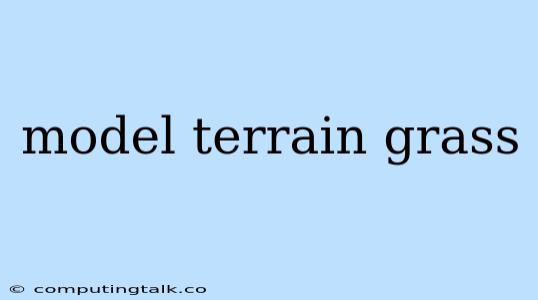Creating Realistic Grass for Your Terrain Models
Creating realistic grass for your terrain models can be a challenging task, but with the right tools and techniques, you can achieve stunning results. Grass is one of the most prevalent features in natural environments, and accurately representing it can drastically enhance the realism of your 3D scenes. This article will explore various methods and approaches to effectively model terrain grass, covering everything from basic techniques to more advanced options.
Understanding the Importance of Grass Detail
Before diving into the methods, it's crucial to understand why accurate grass representation is important. Grass adds depth and texture to your terrain, making it appear more natural and visually appealing. Think about how a grassy field looks different from a barren landscape. The presence of grass contributes to the overall ambiance and realism of your environment. It's not just about filling empty space; it's about creating a believable and immersive experience for your audience.
Techniques for Modeling Terrain Grass
Here are some popular techniques for creating realistic grass in your terrain models:
1. Billboards and Sprites:
- This is a simple and efficient method for creating large areas of grass.
- Billboards are 2D images that always face the camera, giving the illusion of depth.
- Sprites are similar to billboards but can be animated to create wind effects.
- Advantages: Easy to implement, can be rendered quickly, good for large areas of grass.
- Disadvantages: Can look unrealistic from certain angles, lack of true 3D detail.
2. 3D Grass Models:
- This approach utilizes pre-made 3D models of individual grass blades or clumps.
- You can use these models to populate your terrain, achieving a higher level of detail.
- Advantages: Highly realistic, allows for complex shapes and textures.
- Disadvantages: Can be resource-intensive, requires careful placement for best results.
3. Grass Meshes:
- This technique involves creating a mesh of grass blades, often using a procedural generation method.
- You can generate custom grass shapes and textures, controlling the density and distribution.
- Advantages: High level of control, can create unique and diverse grass types.
- Disadvantages: Can be complex to implement, may require advanced scripting or coding.
4. Grass Textures:
- Using a high-resolution grass texture can quickly simulate the appearance of grass.
- This method relies on the illusion created by the texture, rather than individual blades.
- Advantages: Simple to implement, can achieve realistic results with proper texture mapping.
- Disadvantages: May lack detail from close-up views, limited control over individual grass blades.
5. Grass Shader Techniques:
- These shaders use mathematical algorithms to create the appearance of grass dynamically.
- You can control variables like grass density, color, and movement.
- Advantages: Highly efficient, dynamic and realistic, allows for real-time effects.
- Disadvantages: Can be complex to implement, may require knowledge of shaders and programming.
Tips for Creating Realistic Terrain Grass
- Vary the Height and Density: Don't use the same grass height and density across your entire terrain. Create variation to mimic real-world conditions.
- Add Wind Effects: Incorporating wind effects into your grass can add a sense of realism and movement.
- Use Different Grass Types: Mix different grass types to create a more diverse and interesting terrain.
- Consider Lighting and Shadows: The way light interacts with your grass can greatly affect its appearance. Experiment with different lighting setups.
- Pay Attention to Detail: The little things matter. Consider adding imperfections, such as trampled areas or paths through the grass.
Choosing the Right Approach
The best approach for modeling terrain grass depends on your specific needs and project requirements. Consider the following factors when making your decision:
- Budget: How much time and resources are you willing to invest in creating realistic grass?
- Performance: How much impact will your grass solution have on the performance of your game or application?
- Level of Detail: How much detail do you require from your grass?
- Artistic Style: What overall look are you aiming for in your scene?
Conclusion
Modeling realistic grass can significantly enhance the visual appeal and immersiveness of your terrain models. By carefully considering the available techniques, choosing the approach that best suits your project, and applying some helpful tips, you can create stunning and lifelike grass that breathes life into your 3D scenes. Remember, there's no one-size-fits-all solution, so explore different options and experiment until you achieve the desired results.
